The legal tender in the People’s Republic of China is known as the yuan, although its official name is renminbi (“people’s currency” in Chinese).
Its ISO 4217 code is CNY and its symbol is exactly the same as that of the Japanese yen (¥), which is why the yuan is sometimes written with a single horizontal bar, in order to differentiate it from the Japanese currency (which is written with two horizontal bars).
The Chinese yuan is divided into 10 jiao and 100 fen and as of the date of this update (June 3, 2023), the currency equivalence (note that currency is not the same as paper currency) is:
- 1 euro = 7.60 CNY
- 10 yuan = 1.3 euros
History of the Chinese yuan
The renminbi was born in 1949, after the victory of the communist side in the Chinese civil war. The introduction of this new currency by the new government had as its initial objective to recover the battered economy of the country and curb inflation.
The Chinese regime kept the renminbi exchange rate fixed for decades well above its real value. This situation was gradually corrected throughout the 1980s and 1980s.
Already in the 21st century, after the internationalization of the renminbi in 2015, the IMF designated the yuan as one of the main world currencies along with the US dollar, the euro, the British pound and the Japanese yen.
The People’s Bank of China, based in Beijing, is the official issuer of the Chinese yuan, which dedicates a section to the country’s coins and banknotes.
Chinese yuan coins
The Chinese yuan (¥) is divided into 10 jiao and 100 fen. We now list the denominations of each of these coins in circulation in China:
- Fen Coins: 1 (¥0.01), 2 (¥0.02), and 5 (¥0.05).
- Jiao coins: 1 (¥0.1), 5 (¥0.5).
- Yuan coins: 1¥.
The fen coins, which are the “cents” of the yuan, are very small and light, since they are made of aluminum. The 5 jiao is made of brass and the 1 jiao and 1 yuan are made of nickel-plated steel.
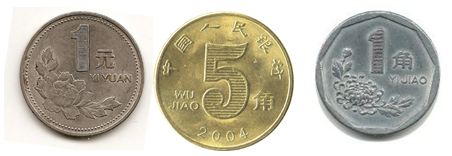
Due to inflation, the value of these coins is almost negligible and they are less and less used.
1 jiao coin
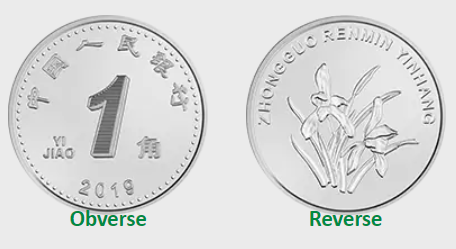
5 jiaos coin
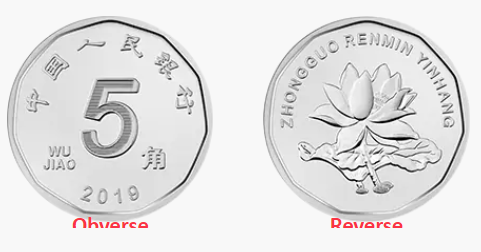
One yuan coin
The one yuan coin has a counter value in euros close to 0.11 euros. Its appearance has been reissued in August 2019.
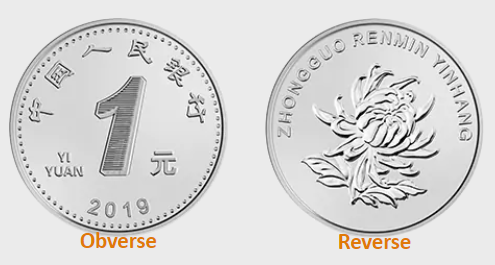
Chinese yuan banknotes
The Chinese government has issued up to five series of renminbi notes since the introduction of this currency in the country: 1948, 1955, 1962, 1987-1997 and 2005.
Currently, despite having different designs, the last two series issued are legal tender and coexist with the same denominations:
- 1¥ yuan note (issued in 1999 and updated in August 2019)
- Five yuan note 5¥ (updated on November 5, 2020)
- Ten yuan note 10¥ (issued in 2005 and updated in August 2019)
- Twenty yuan 20¥ note (issued in 2005 and updated in August 2019)
- Fifty yuan banknote 50¥ (issued in 2005 and updated in August 2019)
- One hundred yuan note 100¥ (issued in 2015)
The greater the value of the banknote, the greater its size in millimeters. The 1, 2 and 5 jiao banknotes, easily recognizable by their small size, are practically out of circulation.
In the last series of 2005 there is a new edition of 1, 10, 20 and 50 yuan banknotes dated August 30, 2019. This redesign adds new security measures, changing the year of issue that appears on the reverse to 2019.
In any case, the effigy of Mao Zedong (1893-1976) is present on all the obverses, unlike the previous series in which the portraits of different worker and revolutionary leaders appear.
In both series, the reverse is dedicated to reproducing some natural landscape or famous monument in China. Let’s see below the banknotes of the new series of Chinese yuan banknotes.
1 yuan banknote
The one yuan (¥1) banknote of August 2019 is a security-enhanced version but with the same design as in 1999, when it came into existence. It measures 130 x 63 mm and has green and yellow colors.
This banknote coexists with the coin of the same value. The equivalent value in euros of this note, in France, June 2023, is small: about 0.12 euros (twelve euro cents). On the obverse Mao appears next to an orchid.
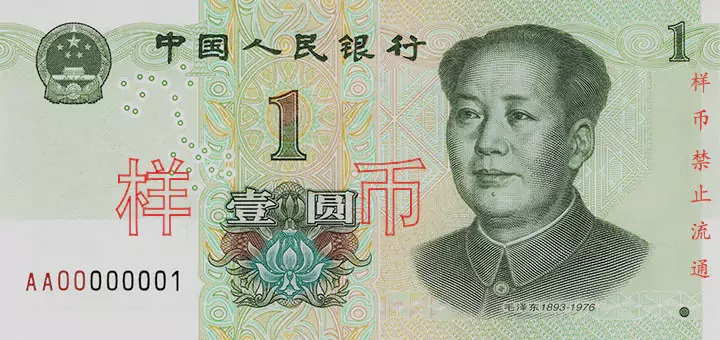
On the reverse a lake with floral decorations.
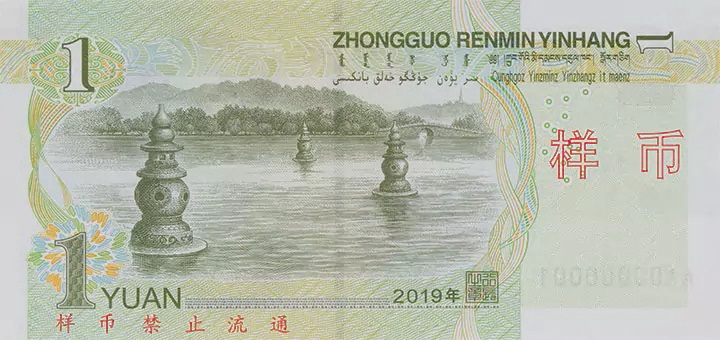
5¥ banknote
The People’s Bank of China has issued the 5 yuan banknote of the fifth RMB series (2020 edition) on November 5, 2020. It looks like this:
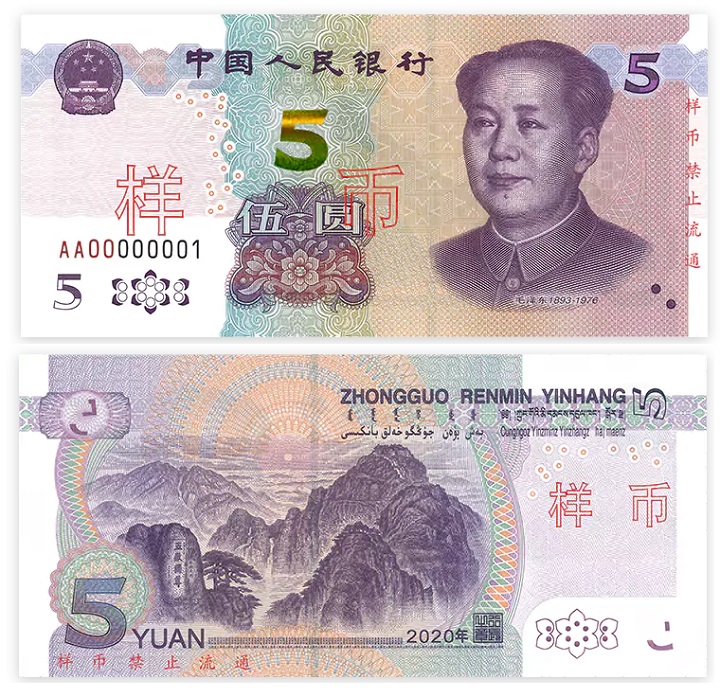
¥10 banknote
On the obverse of this original 10 yuan banknote from 2005 but redesigned in August 2019, Mao’s effigy appears as usual.
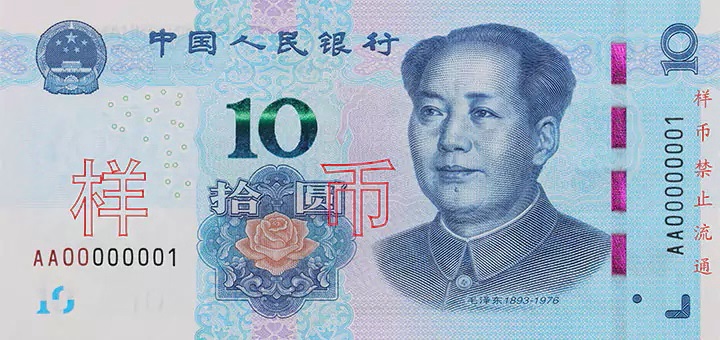
The reverse features an image of the Three Gorges Dam on the Yangtze River, a spectacular feat of Chinese engineering.
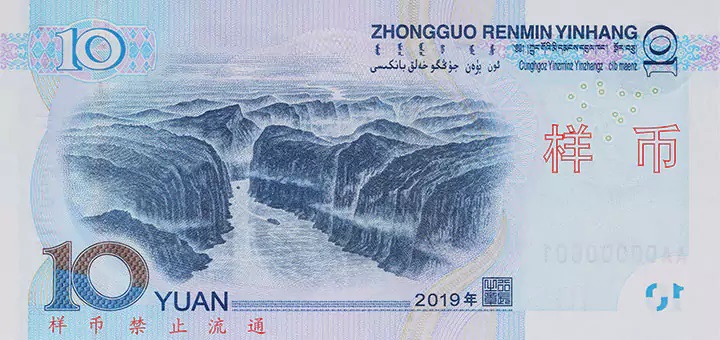
This banknote is blue-green in color and its approximate value in currency suppliers in France, in June 2023, is around 1.10 euros.
On the occasion of the Beijing Olympic Games in 2008, a series of banknotes was issued in which the figure of Mao was replaced by the representation of the famous and spectacular national stadium in the Chinese capital, also known as “bird’s nest”.
The reverse shows representations of athletes in different positions and a discus thrower.
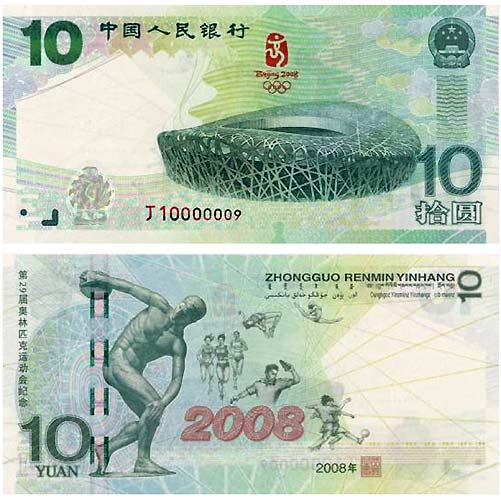
20¥ banknote
The 20 yuan banknote is brown in color and has been redesigned in August 2019 to update its appearance and add security features. Although its design is practically the same as in its original version of 2005.

On the back of the brown 20 yuan banknote, the landscape shown is that of the Li River, in Guilin province, crisscrossed by the bamboo boats of some fishermen.
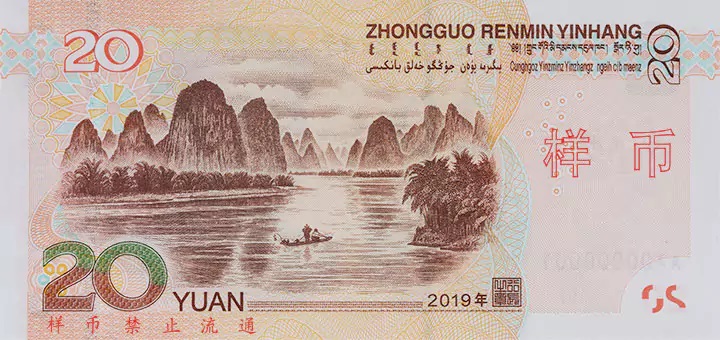
The equivalent value of this banknote to change in France, June 2023, is about 2.37 euros.
50¥ banknote
The 50 yuan banknote is green and somewhat larger than those of smaller denominations. It has been redesigned in August 2019, although its design is practically the same as in its original version of 2005.
The equivalent value in euros of this banknote, in France, June 2023, is about 5.92 euros. The obverse shows Mao with the flower.
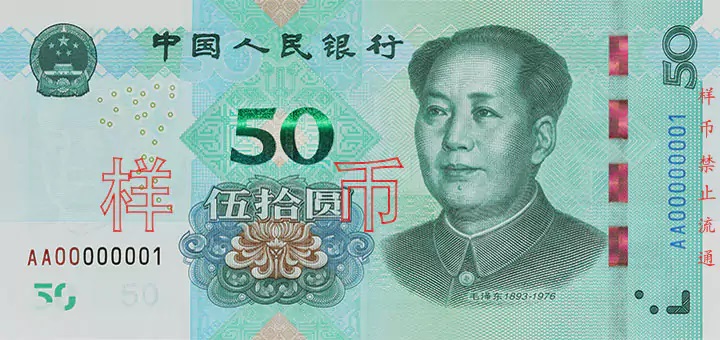
The city of Lhasa, in the Tibet region (under Chinese occupation since 1950) stars on the reverse of the green and purple 50 yuan banknote.
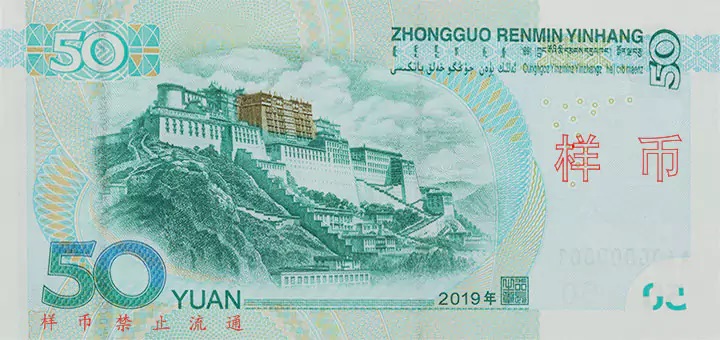
¥100 banknote
It is the banknote with the highest value issued by the Chinese Popular Bank in November 2015. Its equivalent value in euros in France, June 2023, is equivalent to approximately 11.84 euros.
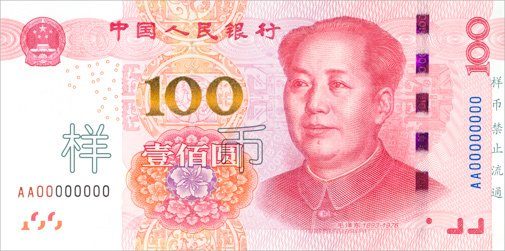
It is red in color and the reverse shows the facade of the Great Hall of the People, located in the emblematic Tiananmen Square in Beijing.
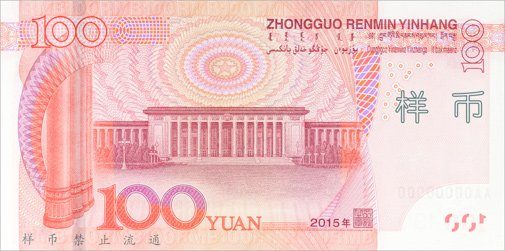
Euro to Chinese yuan exchange rate
The exchange rate of the euro against the Chinese yuan is subject to constant changes and sharp fluctuations. If you search Google for “euro-yuan exchange” you will find dozens of websites (“currency converters”) that offer a “rate” of the day.
You will also see this graph with the prices of that pair of currencies from Google Finance. Something like this (03 June 2023):
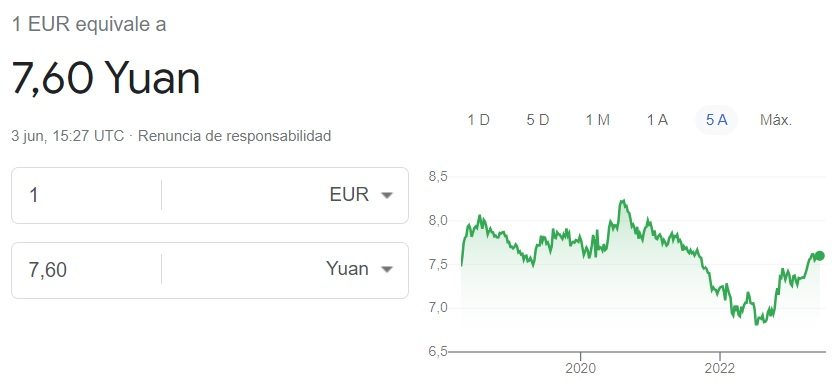
As you can see, the exchange rate for the last five years has fluctuated between CNY 6.90 and CNY 8.26 per euro (in 2004 it was CNY 11.04). But keep in mind that this chart represents the value of the Chinese yuan “currency” against the euro, and not the lower real currency.
In fact, at French currency suppliers you can buy yuan at an exchange rate between 5.24 at the airport and 7.04 CNY at Comparer Devise for each euro.
Nothing to do with the euro to Chinese yuan currency exchange. So, when you see these values in Google and other currency converters with your mobile, you should keep the following in mind:
It is an unofficial rate, and therefore unreliable. In other words, if you click on the “Disclaimer” link, you will get this warning from Google Finance:
- “Google cannot guarantee the accuracy of the exchange rates displayed. Please confirm current rates before making a transaction that may be affected by changes in exchange rates.”
- These rates you see are usually wholesale prices of the Chinese Yuan currency against the Euro currency (currency and banknote currency are not the same).
- This rate can only be obtained by banks among themselves, in the exchange market, that is, it is impossible to obtain it as an individual.
If you need yuan in banknotes, you will have to go through the paper money retail market (banks or currency suppliers).
This market means that the yuan has had to be “transported” by someone for you to enjoy (or purchased from travelers from China passing through France previously).
In other words, moving banknotes from one place to another has logistical costs that will make their sale price more expensive (the exchange rate that will be applied by whoever sells them to you). The renminbi or Chinese yuan is not a very abundant currency in France.
As a result of its scarcity, its price is more expensive in France than in China. If you decide to buy yuan in France, it is good to anticipate the purchase and order them online to obtain a better rate.
Where to exchange Chinese yuans
The three most popular places to exchange Chinese yuan in France are high street banks and currency suppliers and the airport.
Of them, the least recommended place to buy is the airport, which are not specialists and any business that charges you a commission in addition to an “exchange margin” (difference between the price for which you paid the currency and the price for the one they sell it to you).
The big banks sell and buy yuans, but keep in mind that they usually charge you a commission of 2-3% apart from the exchange rate that they apply to you.
In other words, if you change 1,000 euros to yuan, you will pay an additional 25 to 30 euros for the sale (and another commission on your return if they buy back your remaining yuan for euros).
The currency suppliers that collaborate with Comparer Devise do not charge you any commission and have competitive prices.
Euro to yuan exchange rate today
To know the euro-yuan exchange rate in currency suppliers, banks and the airport, in France, the best thing you can do is use our currency comparator.
Click on the link of your interest depending on whether you want to buy yuan or sell it in exchange for euros and you will see where to get the best change in your city (Paris, Lyon, Marseille, Bordeaux, Nantes, Cannes, Strasbourg, Rennes, Orléans, etc.):

Sin comentarios